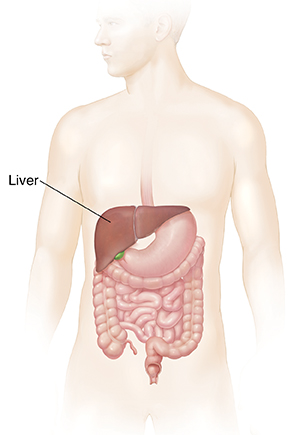Understanding Liver Abscess
A liver abscess is a pocket of pus that forms in the liver. It must be treated right away to prevent serious problems.

How does a liver abscess happen?
A liver abscess most often occurs because of infection from germs such as bacteria, parasites, or fungi. The type of germ determines what type of liver abscess you have:
-
Bacteria cause a pyogenic liver abscess
-
Parasites cause an amebic liver abscess
-
Fungi cause a fungal liver abscess
The infection may have:
-
Spread to your liver from other structures in your belly (abdomen), such as the gallbladder, bile ducts, bowels, or appendix
-
Traveled in your bloodstream to your liver from more distant areas of the body
-
Happened after surgery or an injury to your liver
Symptoms of liver abscess
Symptoms of a liver abscess may take 2 to 4 weeks to appear. They may include:
-
Fever, chills, sweats
-
General discomfort or sick feeling
-
Pain in the upper right part of the belly
-
Weight loss
-
Loss of appetite
-
Nausea, vomiting, or both
-
Diarrhea, constipation, or both
-
Cough
-
Chest pain or shoulder pain
-
Yellowish eyes and skin (jaundice)
Treatment for liver abscess
Treatment depends on the type of liver abscess that you have. To find this out, your provider may put a needle through your skin into the abscess. A sample of pus will be removed and checked. Blood tests and cultures of the blood for infection are done. You will also have imaging tests, such as ultrasound or CT scan or MRI, to evaluate your liver. In many cases, treatment starts in the hospital and continues at home. Treatment may include:
-
Taking medicines, such as antibiotics. These may be given by an IV (intravenous) line placed in a vein in your arm or hand. Or you may take them by mouth. You may need the medicines for a few weeks or longer.
-
Draining the pus from the abscess. The healthcare provider may do this using a needle or tube (catheter) put through your skin. In severe cases, the healthcare provider may make a cut (incision) through your skin to reach your liver.
-
Having imaging tests after treatment. In many cases, your healthcare provider will order follow-up tests of your liver after treatment. This is often done by ultrasound, CT scan, or MRI.
Possible complications of liver abscess
These can include:
-
Burst (ruptured) abscess
-
Infection spreading into other parts of the body such as the blood, belly, lungs, heart, brain, and eyes
-
Death
When to call your healthcare provider
Call your healthcare provider right away if you have any of these:
-
Symptoms, such as fever or pain, that don’t get better with treatment or get worse
-
Yellowish skin or eyes (jaundice)
-
New symptoms, such as trouble breathing
Online Medical Reviewer:
Jen Lehrer MD
Online Medical Reviewer:
L Renee Watson MSN RN
Online Medical Reviewer:
Raymond Turley Jr PA-C
Date Last Reviewed:
5/1/2022
© 2000-2024 The StayWell Company, LLC. All rights reserved. This information is not intended as a substitute for professional medical care. Always follow your healthcare professional's instructions.